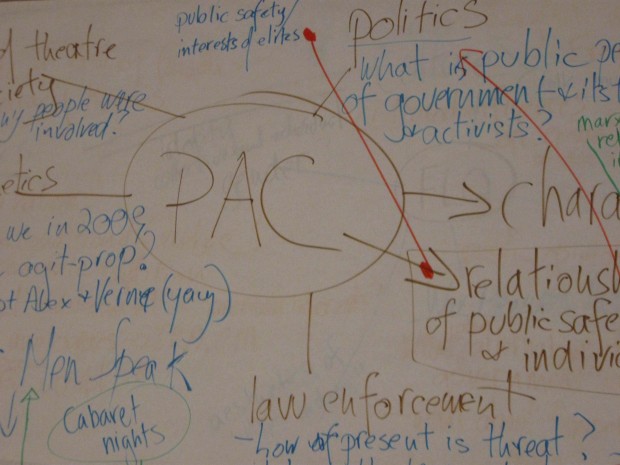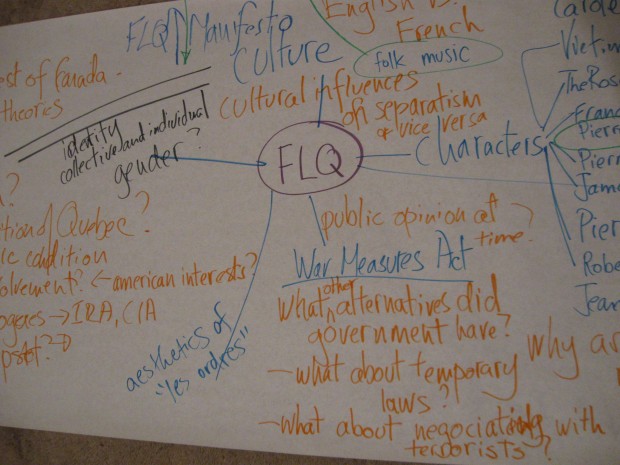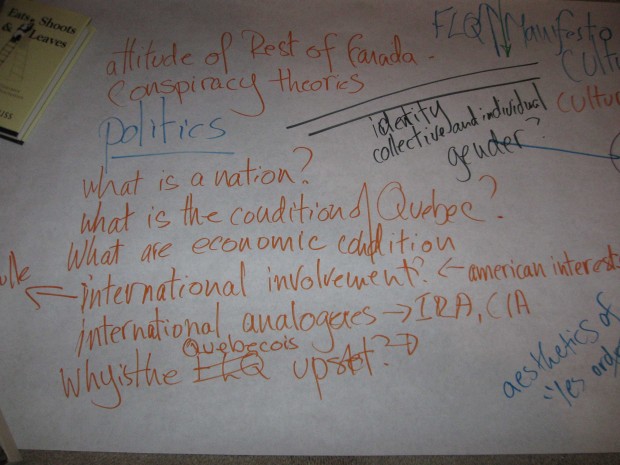Section 98 – Open Source Entry #1 – Introduction: What a tangled web we weave
by Aislinn Rose
Welcome to Praxis Theatre’s “Open Source Theatre Project”, that will lead you through our development process for Section 98 from January, through to our workshop presentation at HATCH in March, and onto the next phase of development after that. True to the spirit of all things “Open Source”, we want to show you our material as it is created, and we want to hear back from you. What are we missing? What haven’t we thought of? Is there a youtube video or a CBC archive that you think would be really helpful? Here, you will find the “source code” of Section 98.
I have been charged with the responsibility of preparing and maintaining these posts, and I’m hoping that you’ll use this site to engage and interact with us in our exploration of some very complicated and layered issues. I started working with Praxis in 2009 during the development of the first iteration of this project for the Toronto Fringe Festival, called Tim Buck 2 and it has been incredible working with a group of peers to create theatrical materials out of court transcripts, newspaper articles, history textbooks, and thin air. I want to share that process with you.
The HATCH development stage of Praxis Theatre’s Section 98 addresses the complex history of civil rights in Canada by exploring unionists and socialists in the 1930s, the FLQ and the October Crisis in the 1970s, as well reserving a portion of the production to consider contemporary events that relate to civil rights in Canada.
To aid in this creation process, our dramaturg Alex Fallis has been leading us through a process that began with a mapping exercise. For each major topic we began to plot out the related subtopics that would require further research, and that were of particular interest to us. Laying out the individual eras visually made it immediately apparent, what we didn’t know.
Starting with the era of the Progressive Arts Club in the 1930s, we established the various issues that we felt were important to consider:
- Politics
- Law enforcement
- Aesthetics
- Place of theatre in society
- The relationship between individual rights and public safety
- Characters, etc.
Then item by item we asked ourselves, “what don’t we know?”
The topic of aesthetics brought up the question, “why, in 2009, do we hate Agitprop?”. Politics raised questions of the public perception of government tactics of the time, and so on.
From there we moved on to our 2nd era, the FLQ in the 1970s. We were interested in looking at:
- War Measures Act
- Politics
- Characters
- FLQ Manifesto
- Quebec culture and artists
The general consensus amongst our anglo and bilingual creative team was that we were widely ignorant of anything more that the bare facts and events surrounding this era.. Luckily Alex has been encouraging us to warmly embrace the concept of “how ignorant are we?” when tackling these big topics. So here are some of the things we decided we need to know more about:
- What alternatives did the government have to the War Measures Act?
- What is a nation?
- What was the economic condition of Quebec?
- What was the attitude of the rest of the country at that time?
- How did the RCMP determine who to arrest?
- What is a political prisoner?
From there, we set the two maps side by side to look for the issues and/or questions that connected them… similar questions/character types/the role of the Prime Minister, etc. Then it was a matter of picking out the elements that interested us to research and present at the next research session in a presentation that was interactive and/or performative in some way.
As a bit of group research, we also got together recently for a movie night. Pizza, beer, brownies, and a copy of Les Ordres, a 1974 Cinema Verite piece that won Michel Brault a Best Director prize at Cannes, and tells the story of the incarcerated civilians while the War Measures Act was in place during the October Crisis.
Near the end of the film as prisoners are being released, one of them shouts out “next time there’ll be a trial in the streets!”. So I’ve been thinking, given this situation, and people like Omar Khadr sitting in Guantanamo Bay for 7 years from the age of 15, at what point do systems or Governments create the very movements they are trying to suppress?
CLICK HERE FOR FULL OVERVIEW OF SECTION 98 AND THE OPEN SOURCE PROCESS





I am struck by the idea of the collective embracing its own ignorance about the topics explored and am sure that the deeper you go, the clearer these historical and contemporary climates will become. However, what will you do to communicate these messages to an audience who today may be as ignoarnt as you were when your process began? Will we need to know as much as you in order to live this play’s story? Could you go so far in development that the performance language created is too narrow? It’s a fine line, n’est ce pas? MT
Thanks for the great question Margaret. This “fine line” that you mention is definitely something that we considered throughout our development of Tim Buck 2, the first iteration of this project, and it’s something we continue to think about as we develop Section 98: how to present what we have discovered without alienating our audience, and without becoming overly didactic in our methods.
As an example of this challenge in Tim Buck 2, we needed to find a way of giving the audience the history of Section 98 of the Canadian Criminal Code. In an effort to compact as much information into as little time as possible, we created “Section 98 in 2 Minutes or Less”, where we used a somewhat modernized version of “chalk drawings”, an aesthetic of the period we were exploring, to deliver important information in an entertaining yet informative way.
Let’s throw Jon Stewart’s The Daily Show into the debate: when I watch the show I don’t feel like I have to be completely up to date on American politics and politicians in order to be both educated and entertained. However, we know that there is a team of researchers in the background putting this information together. Your thoughts?
As a writer, actor, and supply teacher (hoping to have my own class soon!), I think this process is extraordinarily valuable, with respect to the arts, cultural and political communities, and students of all ages. I would love to integrate this process and blog into my future high school history classes–or drama classes. The cross-curricular potential is limitless.
I agree that it will be a challenge to convey the information and knowledge accumulated, while creating a full, absorbing, theatrical narrative, but I like the Jon Stewart example. My one concern would be the extent to which bias is inherent in an emotional or personal narrative drawn from facts, and/or the larger public sphere.(Although in his case, it’s less of a concern, as I usually agree with his bias. And that said, a bias does not necessarily mean something is not still worthwhile and valuable.)
The other perhaps simpler issue that I would anticipate would be becoming overwhelmed… I co-facilitated a theatre project in Kibera Slums, in Kenya, where we attempted to explore and distill local issues with a team of local artists, on chart paper, much like the photos posted above. Our collective research period was less / non-existent, as were were exploring something immediate, such as a lack of toilets and sewage pipes, and something participants had to deal with on a daily basis. So they knew the issues personally and intimately. But it was still a challenge for everyone to narrow our focus and then knit everything together. How will you eventually choose which details, stories, and issues are left behind? (In our case, albeit a different sort of project, a democratic vote cleared the path forward.)
Aislinn! What a great discussion your post has already generated. Fantastic.
Margaret – Check out this post by National Arts Centre company member and theatre blogger Kris Joseph on how in a best-case scenario this sort of work can lead to a different relationship between audience and theatre artist. Hopefully we can encourage a new relationship that occurs beyond the 2 hours that everyone is in the same place as part of a final performance.
http://www.krisjoseph.ca/2009/10/27/porosity/
Laura – Your work sounds fascinating. Not to be cryptic – but please come check this website for a big announcement on Monday that may interest you….As for bias, I have plenty. As does BellGlobeCTVmedia, as does The National Post, as does your local community newspaper. The only problem I’ve ever seen bias make for art and communication is when people act like they don’t have one.